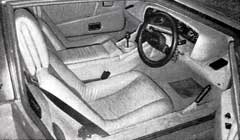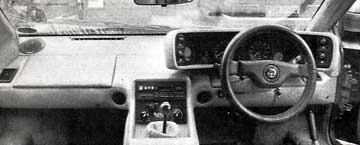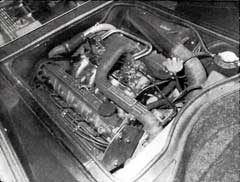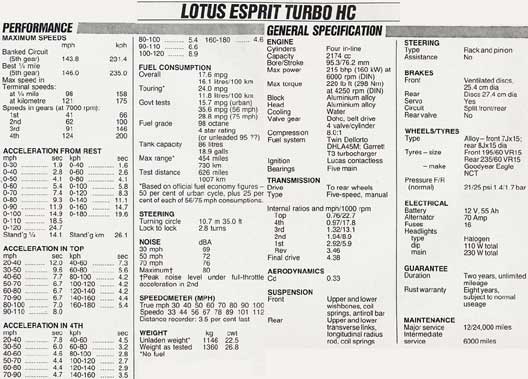

Lotus Turbo Esprit HC
A high-compression cylinder head gives
the 1987 Turbo Esprit more power to exploit
its excellent handling. The flaws remain, but there are few more exciting
cars at the price.
Motor, 28 February 1987
Seven years from its debut, the Lotus Turbo Esprit is still going strong. Now, the latest 215bhp HC (high compression) version promises even more performance for the stunning mid-engined exotic. It looks set to expand upon Lotus' recent success – undercutting recent price-inflated Italian and German rivals by five-figure sums.
The Turbo Esprit HC costs no more than the old car, remaining at £24,980 – around £5400 more expensive than the un-blown Esprit, which shares the same steel chassis and glass-fibre two seater body. The now 12-year-old Chapman design looks substantially unchanged from the outside – only the 'hc' decals distinguish it from the original Turbo – but the 1987 model benefits from a host of subtle engineering improvements.
Most of these relate to the 2174cc all-aluminium 16-valve dohc engine; the compression ratio has been raised from 7.5:1 to 8.0:1, while the turbocharger boost has been raised from 0.55 bar (8 psi) to 0.6 bar (9.5 psi). As before, the Garrett T3 turbocharger blows directly through a pair of twin-coke Dellortos – though these are now larger 45M DHLA instead of 40 DHLA. The size of the turbine housing has been reduced to improve low-speed throttle response, and a throttle jack has been fitted to lower hydrocarbon emissions on the overrun and it increase idle speed when the (optional) air conditioning is working. There's also a balance pipe fitted to improve cylinder-to-cylinder fuel distribution. Other changes to the induction include larger port areas, bigger inlet valve throats and changes to the exhaust manifold castings, but surprisingly, there is no intercooler to cool the inlet charge.
The net result of these changes is a mere 2.4 per cent increase in power output (from 210bhp @ 6500rpm, to 215bhp @ 6000rpm), but a sizeable 10 per cent more torque (220lb ft instead of 200lb ft, as the same 4250rpm peak revs).
Other improvements deal with the inevitable thermal problems of a relatively small high-output turbocharged engine – there's a higher capacity water pump, more effective oil and water radiators and an extra air duct for better engine bay cooling.
Inside, the HC gets the benefit of adjustable rake seats, while the tailgate can now be opened by a lever in the driver's door jamb.
As is well known, the original Turbo Esprit was noted for its responsive and lag-free turbocharged engine. It impressed particularly with its smooth, even power progression and complete lack of temperament whether slogging at 1000rpm or screaming at 7000rpm.
The HC is faster, but the gains are small. Flat out, it circles round the Millbrook bowl at a mean 143.8mph, just 2.9mph faster than the old car – and nowhere in sight of much faster, albeit larger-engined, rivals like the Renault GTA (151.4 mph) and Ferrari 328GTB (158.5 mph). On the flat the Esprit would have gone a little faster, though the maker's 152mph claim – corresponding to 6700 rpm in fifth – seems a little optimistic. No, devastating acceleration is what the Esprit is all about. Aided by comparatively low weight (1146kg) and good traction as a result of the mid-engined layout, the Esprit blasts to 60mph in 5.4 sec – still in second gear – improving on its predecessor's performance by just 0.2 sec.

A small improvement maybe, but by this yardstick the Lotus just leads its more expensive rivals – the fastest of which are the Ferrari (5.5 sec), Renault (6.0 sec) and TVR 350i (6.5 sec). By 100mph, reached in 14.9 sec, the gains compared with the old car (15.4 sec) are more marked. Of the rivals, only the Ferrari (13.8 sec) cracks the 15 sec barrier.
But getting the best from the Lotus is not easy. From a standing start, it's all to easy for the engine to bog down as traction momentarily gets the better of the engine's power build-up. And the heavy, cantankerous gearshift (the transaxle is still that of the long-departed Citroën SM) tends to preclude lightning-fast gearshifts, unless the driver exercises a firm positive wrist. Certainly, there's no way that the Esprit can match the Excel, with its slick-shifting Toyota gearbox, and there's a temptation to use the transmission less as a result.
The in-gear times are clearly those of a turbocharged car. The HC covers the fourth gear 30 to 50 mph slog in 6.0 secs, marginally better than the original Turbo (6.2 sec) – but inferior to the Ferrari 328 GTB (4.8 sec) and Renault GTA (5.7 sec). So bottom-end punch is still good, but it's in the mid-range that the turbocharger's not-so-silent assistance makes itself more obviously felt. All the fourth-gear 20 mph speed range increments between 40 and 90 mph takes less than five seconds, for example.
But despite this on-paper advantage over the original car, it's not all gain. Because of the extra power on-boost, the engine feels much more obviously turbocharged, and the test car had an inconsistent throttle response, often causing a hiccup when the power was reapplied: this made smooth gearshifts especially difficult. Another problem was the occasional bout of temperament in low-speed stop-start motoring while hot starting sometimes demanded a few seconds' churning to overcome over-richness – no matter that the Turbo HC has a water temperature controlled pump to purge hot fuel vapour from the induction system when the engine has been switched off.
The 17.6 mpg overall fuel consumption might be judged as poor for a 2.2-litre car, but it's acceptable for one with the Esprit's performance. Comparative figures for the rivals range from the Ferrari's 18.9 mpg, to the Porsche's 21.9 mpg. A touring consumption of 24.0 mpg promises a 450-mile range on a tankful of four-star – though the HC will also run on unleaded fuel.
One thing that hasn't changed is the power unit's extreme smoothness and impressive general refinement. It runs even the Porsche 944 Turbo close in this respect, no matter that the Lotus engine lacks the German one's balance shafts, and that it resides much closer to the occupant's ears. So there's no inhibition towards using this car's full performance, other than keeping it on the road and staying within the law...
With no major chassis changes – the Esprit continues with upper wishbones and lower transverse links at the front, with single upper and twin transverse lower links and radius arms at the back – but with a new specification of Goodyear NCT tyres (195/60 x 15 front, 235/60 x 15 rear) the Esprit's handling is better than ever.
It's true that the steering effort as parking speeds is very high (there's no assistance), and that the mechanism's high gearing can make the car feel twitchy in motorway driving on first acquaintance, but there the criticism ends. On dry roads, the grip levels are so prodigious that many owners may not transgress them. Pressed very hard, there's enough stabilising understeer to make the car safe in the hands of the less experienced, and yet – with the Turbo – there's the option to neutralise this, or turn it into progressive oversteer. The strong self-centring action of the steering makes correction largely automatic and very neat. More respect is needed on wet roads though, and insensitive throttle application can result in pendulous tail slides for the unwary.
Drive the Esprit over really demanding surfaces and the ride is unexpectedly supple, almost limousine-smooth. There's always firm control when it's needed, however – when cresting a brow or dealing with a series of undulations for example. And the car's responses to the helm are never less than crisp.
The brakes are lighter than you'd expect, but near perfect in progression. For the HC, the all-disc system gets its assistance from a separate vacuum pump, instead of having to rely on manifold vacuum (which disappears when the turbocharger is working!).
Despite the fact that the engine is subdued, the Lotus is not a quiet car overall: there's the inevitable road roar from the fat tyres, and far too much wind noise from the single-seal door frames for that. The driving position is comfortable for those of average height – though the fact that seats now recline doesn't improve the rather marginal legroom and headroom. And as before, over-the-shoulder rear vision is practically non-existent – though the view directly behind through the slatted tailgate cover isn't too bad.
Other points that first-time Esprit drivers will notice include the very closely-grouped pedals (ideal for heel and toeing), the large number of rather reflection-prone Smiths instruments housed in the instrument pod, and a number of old fashioned Austin Rover proprietary parts like the stalk controls, door handles and minor switchgear.

Costing £24,980, the Lotus Turbo Esprit HC is reasonably well equipped – but leather trim, air conditioning, metallic paint and audio equipment are all costly options.
Nevertheless, even with the full complement fitted, the Lotus still costs considerably less than rivals such as the Ferrari 328GTB (£38,980), and Porsche 944 Turbo (£34,168) – neither of which offer much more usable on-the-road performance – and for this reason we have listed the cheaper, albeit slower 944S. The strongest rival though comes from France in the shape of the Renault GTA Turbo (£23,635) – a car in much the same mould as the Lotus, produced by the small specialist company (Alpine). Other contenders strong on performance, image and presence but at a lower price include the TVR 350i (£18,275) and Ford Sierra Cosworth (£17,100) which, despite having four seats, shares a similar small capacity turbocharged 16-valve four cylinder engine to the Lotus.
As you will have gathered from the foregoing, the Turbo Esprit has some serious flaws, and can in no way be regarded as a 'sensible' purchase like the Porsche 944S, costing a similar amount. But, for those who crave the maximum excitement for the money, and to whom the impact of the Esprit's shape matters, there is no substitute.








|
|